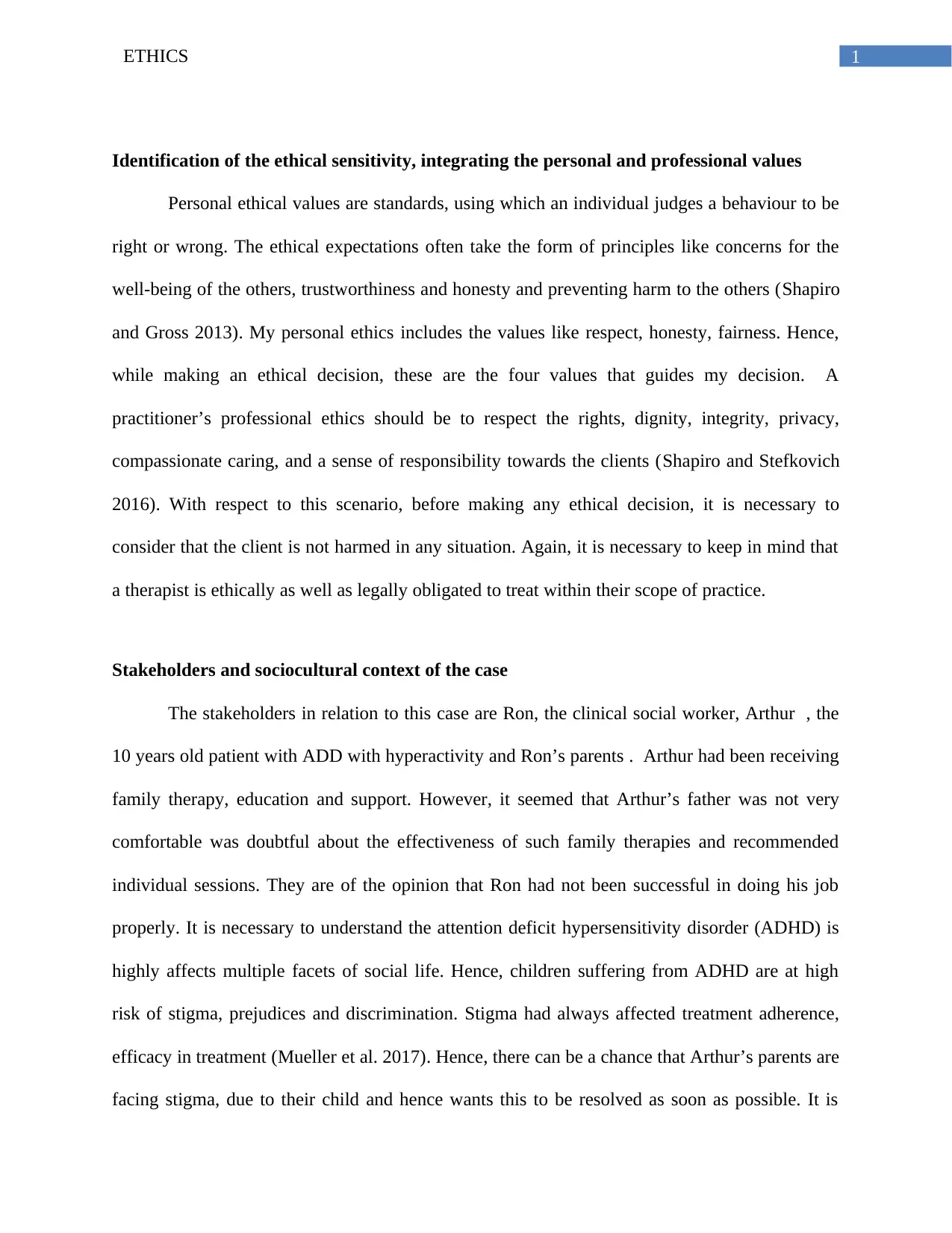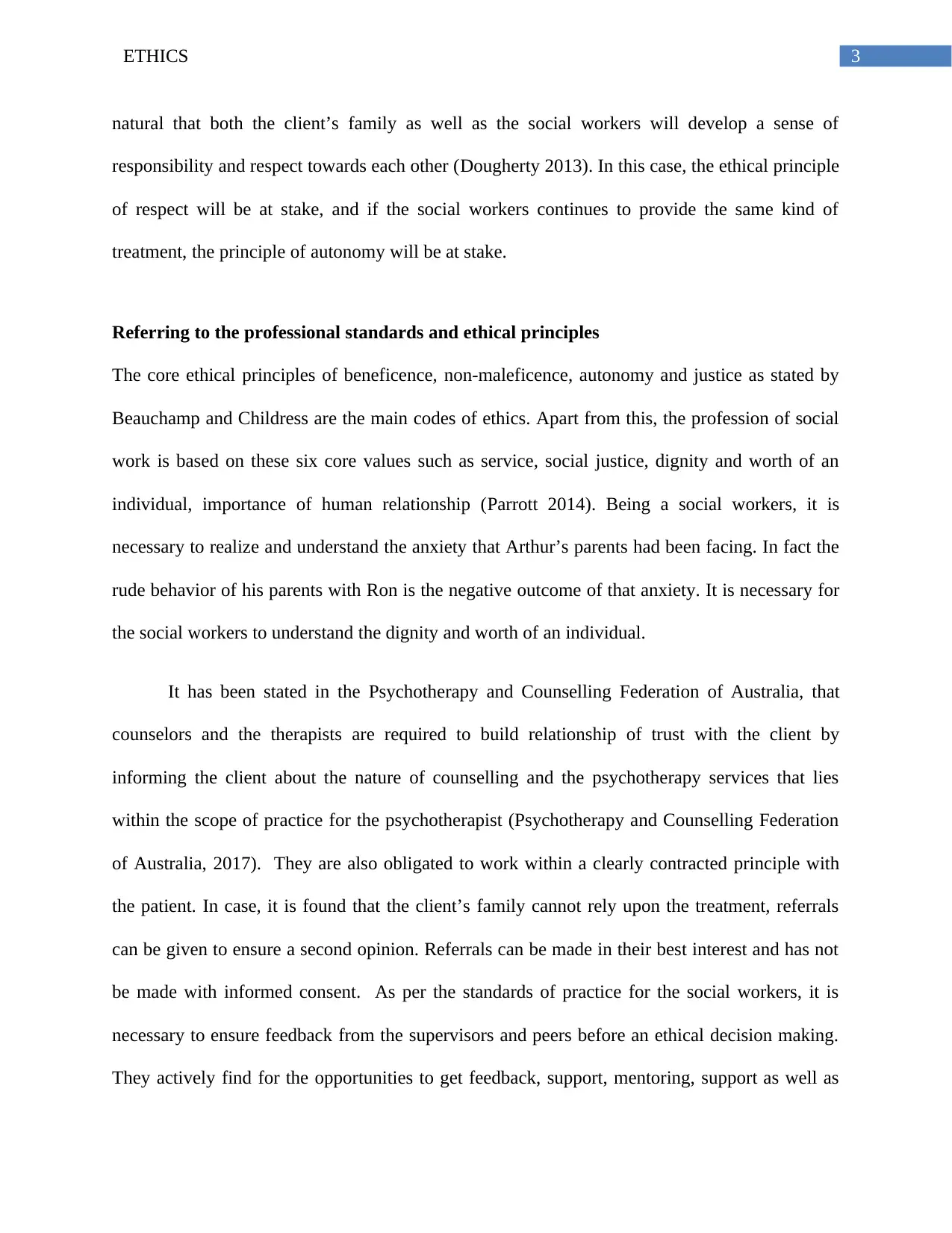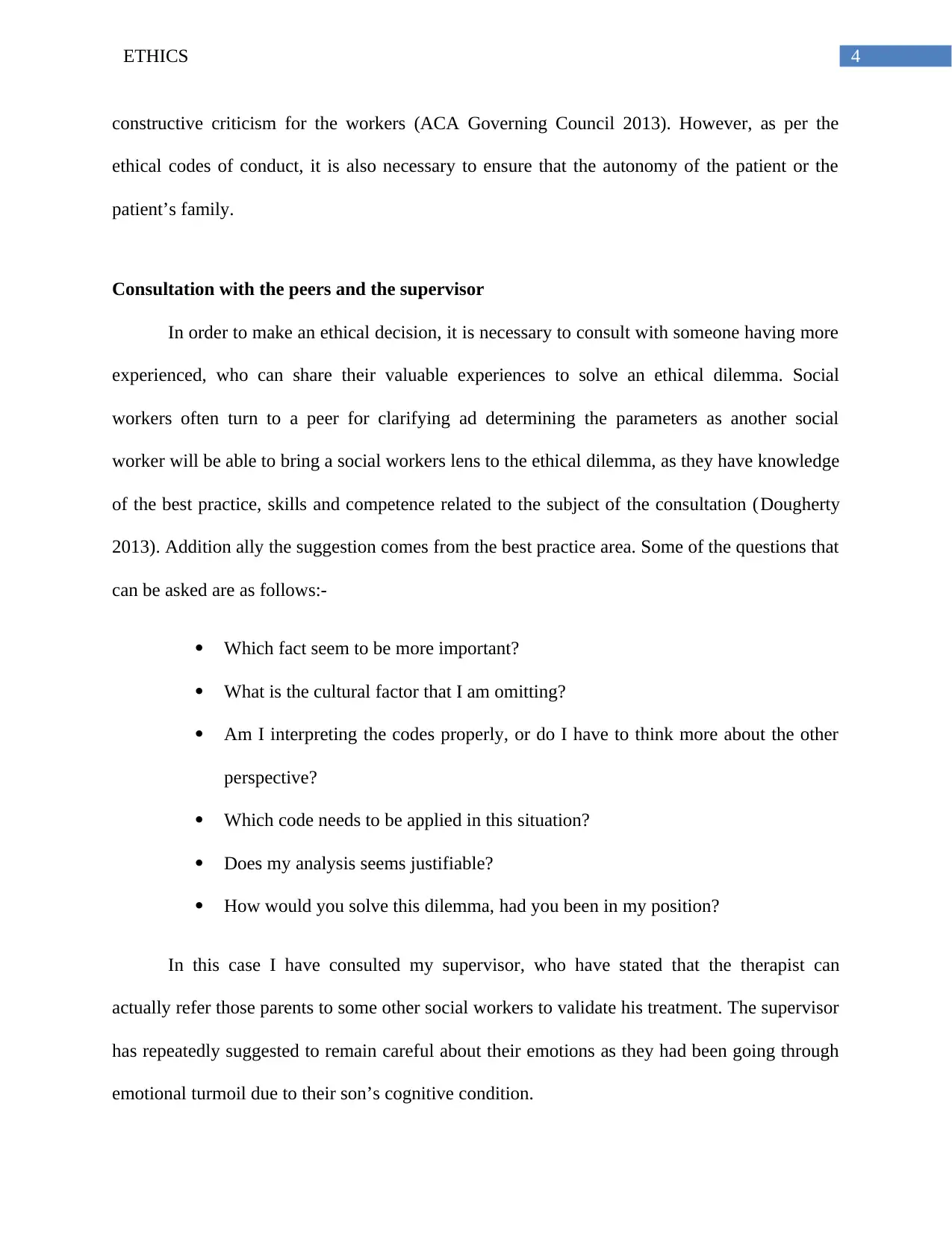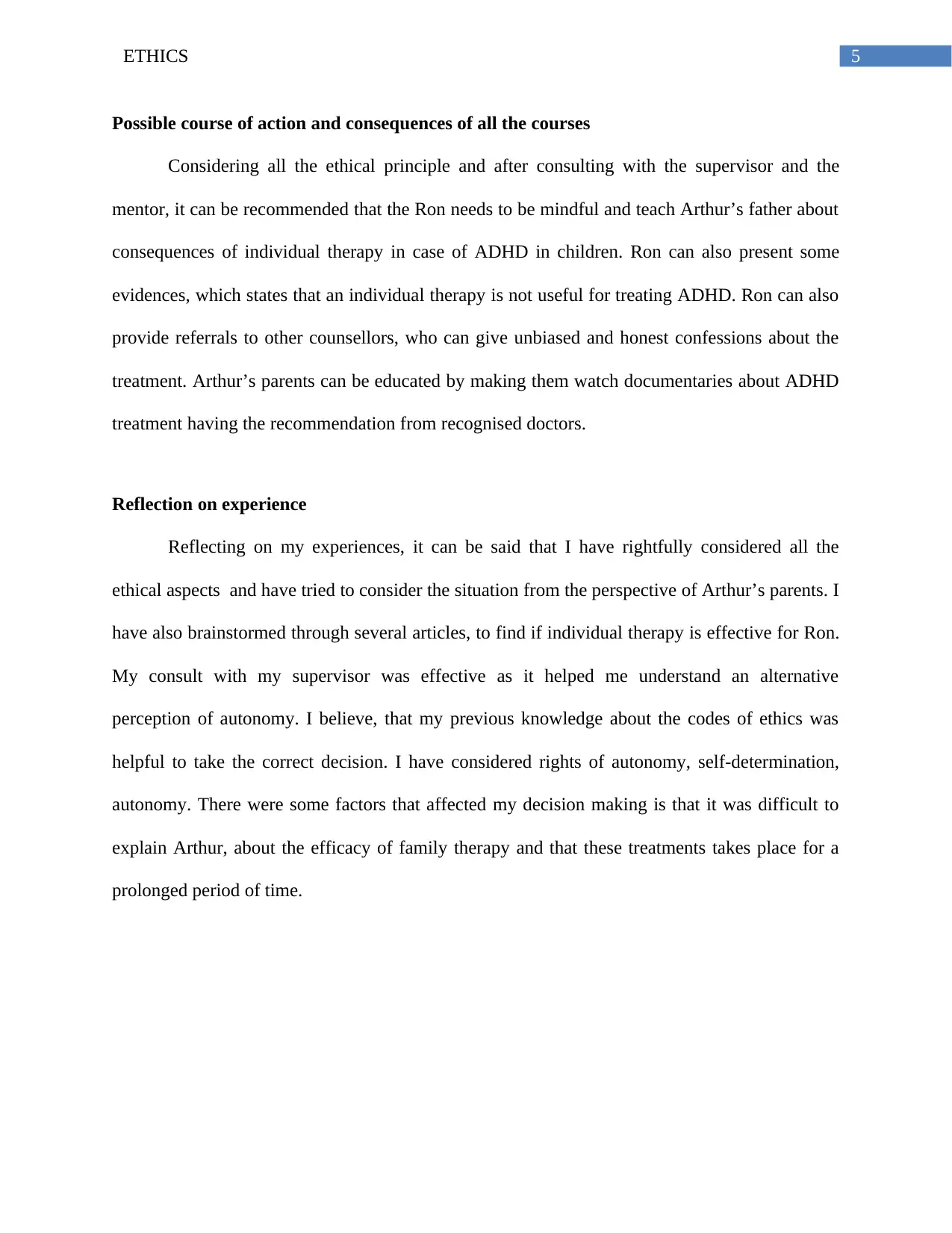Identification of the Ethical Sensitivity
VerifiedAdded on 2022/08/30
|7
|1906
|34
AI Summary
Contribute Materials
Your contribution can guide someone’s learning journey. Share your
documents today.

Running head: ETHICS
ETHICS
Name of the Student
Name of the university
Author’s note
ETHICS
Name of the Student
Name of the university
Author’s note
Secure Best Marks with AI Grader
Need help grading? Try our AI Grader for instant feedback on your assignments.

1ETHICS
Identification of the ethical sensitivity, integrating the personal and professional values
Personal ethical values are standards, using which an individual judges a behaviour to be
right or wrong. The ethical expectations often take the form of principles like concerns for the
well-being of the others, trustworthiness and honesty and preventing harm to the others (Shapiro
and Gross 2013). My personal ethics includes the values like respect, honesty, fairness. Hence,
while making an ethical decision, these are the four values that guides my decision. A
practitioner’s professional ethics should be to respect the rights, dignity, integrity, privacy,
compassionate caring, and a sense of responsibility towards the clients (Shapiro and Stefkovich
2016). With respect to this scenario, before making any ethical decision, it is necessary to
consider that the client is not harmed in any situation. Again, it is necessary to keep in mind that
a therapist is ethically as well as legally obligated to treat within their scope of practice.
Stakeholders and sociocultural context of the case
The stakeholders in relation to this case are Ron, the clinical social worker, Arthur , the
10 years old patient with ADD with hyperactivity and Ron’s parents . Arthur had been receiving
family therapy, education and support. However, it seemed that Arthur’s father was not very
comfortable was doubtful about the effectiveness of such family therapies and recommended
individual sessions. They are of the opinion that Ron had not been successful in doing his job
properly. It is necessary to understand the attention deficit hypersensitivity disorder (ADHD) is
highly affects multiple facets of social life. Hence, children suffering from ADHD are at high
risk of stigma, prejudices and discrimination. Stigma had always affected treatment adherence,
efficacy in treatment (Mueller et al. 2017). Hence, there can be a chance that Arthur’s parents are
facing stigma, due to their child and hence wants this to be resolved as soon as possible. It is
Identification of the ethical sensitivity, integrating the personal and professional values
Personal ethical values are standards, using which an individual judges a behaviour to be
right or wrong. The ethical expectations often take the form of principles like concerns for the
well-being of the others, trustworthiness and honesty and preventing harm to the others (Shapiro
and Gross 2013). My personal ethics includes the values like respect, honesty, fairness. Hence,
while making an ethical decision, these are the four values that guides my decision. A
practitioner’s professional ethics should be to respect the rights, dignity, integrity, privacy,
compassionate caring, and a sense of responsibility towards the clients (Shapiro and Stefkovich
2016). With respect to this scenario, before making any ethical decision, it is necessary to
consider that the client is not harmed in any situation. Again, it is necessary to keep in mind that
a therapist is ethically as well as legally obligated to treat within their scope of practice.
Stakeholders and sociocultural context of the case
The stakeholders in relation to this case are Ron, the clinical social worker, Arthur , the
10 years old patient with ADD with hyperactivity and Ron’s parents . Arthur had been receiving
family therapy, education and support. However, it seemed that Arthur’s father was not very
comfortable was doubtful about the effectiveness of such family therapies and recommended
individual sessions. They are of the opinion that Ron had not been successful in doing his job
properly. It is necessary to understand the attention deficit hypersensitivity disorder (ADHD) is
highly affects multiple facets of social life. Hence, children suffering from ADHD are at high
risk of stigma, prejudices and discrimination. Stigma had always affected treatment adherence,
efficacy in treatment (Mueller et al. 2017). Hence, there can be a chance that Arthur’s parents are
facing stigma, due to their child and hence wants this to be resolved as soon as possible. It is

2ETHICS
necessary to understand the health beliefs of the family as lack of the health literacy compels
them to take odd decisions, or in this case they might have been recommended by some family
members or friends, about the effectiveness of individual therapy, but has necessarily forgotten
the types of conditions, for which individual therapies are suitable. Again, certain websites
provides anecdotal records or incorrect information about the actual treatment of ADHD.
Arthur’s father might have followed them and have inferred that his son is not receiving proper
treatment.
Central issue of dilemma and the available options
The central dilemma in this case study is that Ron is being forced to take up individual
therapy with Arthur, or else Arthur’s parents have decided to drop out from the therapy, even if
individual therapy is not suitable for this kind of disorder. Arthur, being a child is unable to take
decision of his own therapy and the entire decision is taken by his parents. Being a therapist, it is
his duty to abide by the client’s wishes, but it is also necessary that patient safety will be at the
first place and should never be compromised in any way. Hence, an ethical dilemma lies as of
which action should be chosen by the therapist (Reamer 2013). Patients and their family often
fails to comply with the recommendations for the treatment and the non-compliance has a wide
variety of manifestations. A non-compliance often strains the relationship between the patient
and the physician forcing the therapist to take an active part in the treatment. In this case, it is the
duty of the parents to rely on the treatment of a professional, but they are more guided by
emotions and wanted to get a drastic visible results. In this case the principle of ethical
leadership that is at stake is respect (Flite and Harman 2013). There are certain common
emotions that are often faced by the therapists as well as the client and the family during the
course of the treatment. With the establishment of a therapeutic relationship with the client, it is
necessary to understand the health beliefs of the family as lack of the health literacy compels
them to take odd decisions, or in this case they might have been recommended by some family
members or friends, about the effectiveness of individual therapy, but has necessarily forgotten
the types of conditions, for which individual therapies are suitable. Again, certain websites
provides anecdotal records or incorrect information about the actual treatment of ADHD.
Arthur’s father might have followed them and have inferred that his son is not receiving proper
treatment.
Central issue of dilemma and the available options
The central dilemma in this case study is that Ron is being forced to take up individual
therapy with Arthur, or else Arthur’s parents have decided to drop out from the therapy, even if
individual therapy is not suitable for this kind of disorder. Arthur, being a child is unable to take
decision of his own therapy and the entire decision is taken by his parents. Being a therapist, it is
his duty to abide by the client’s wishes, but it is also necessary that patient safety will be at the
first place and should never be compromised in any way. Hence, an ethical dilemma lies as of
which action should be chosen by the therapist (Reamer 2013). Patients and their family often
fails to comply with the recommendations for the treatment and the non-compliance has a wide
variety of manifestations. A non-compliance often strains the relationship between the patient
and the physician forcing the therapist to take an active part in the treatment. In this case, it is the
duty of the parents to rely on the treatment of a professional, but they are more guided by
emotions and wanted to get a drastic visible results. In this case the principle of ethical
leadership that is at stake is respect (Flite and Harman 2013). There are certain common
emotions that are often faced by the therapists as well as the client and the family during the
course of the treatment. With the establishment of a therapeutic relationship with the client, it is

3ETHICS
natural that both the client’s family as well as the social workers will develop a sense of
responsibility and respect towards each other (Dougherty 2013). In this case, the ethical principle
of respect will be at stake, and if the social workers continues to provide the same kind of
treatment, the principle of autonomy will be at stake.
Referring to the professional standards and ethical principles
The core ethical principles of beneficence, non-maleficence, autonomy and justice as stated by
Beauchamp and Childress are the main codes of ethics. Apart from this, the profession of social
work is based on these six core values such as service, social justice, dignity and worth of an
individual, importance of human relationship (Parrott 2014). Being a social workers, it is
necessary to realize and understand the anxiety that Arthur’s parents had been facing. In fact the
rude behavior of his parents with Ron is the negative outcome of that anxiety. It is necessary for
the social workers to understand the dignity and worth of an individual.
It has been stated in the Psychotherapy and Counselling Federation of Australia, that
counselors and the therapists are required to build relationship of trust with the client by
informing the client about the nature of counselling and the psychotherapy services that lies
within the scope of practice for the psychotherapist (Psychotherapy and Counselling Federation
of Australia, 2017). They are also obligated to work within a clearly contracted principle with
the patient. In case, it is found that the client’s family cannot rely upon the treatment, referrals
can be given to ensure a second opinion. Referrals can be made in their best interest and has not
be made with informed consent. As per the standards of practice for the social workers, it is
necessary to ensure feedback from the supervisors and peers before an ethical decision making.
They actively find for the opportunities to get feedback, support, mentoring, support as well as
natural that both the client’s family as well as the social workers will develop a sense of
responsibility and respect towards each other (Dougherty 2013). In this case, the ethical principle
of respect will be at stake, and if the social workers continues to provide the same kind of
treatment, the principle of autonomy will be at stake.
Referring to the professional standards and ethical principles
The core ethical principles of beneficence, non-maleficence, autonomy and justice as stated by
Beauchamp and Childress are the main codes of ethics. Apart from this, the profession of social
work is based on these six core values such as service, social justice, dignity and worth of an
individual, importance of human relationship (Parrott 2014). Being a social workers, it is
necessary to realize and understand the anxiety that Arthur’s parents had been facing. In fact the
rude behavior of his parents with Ron is the negative outcome of that anxiety. It is necessary for
the social workers to understand the dignity and worth of an individual.
It has been stated in the Psychotherapy and Counselling Federation of Australia, that
counselors and the therapists are required to build relationship of trust with the client by
informing the client about the nature of counselling and the psychotherapy services that lies
within the scope of practice for the psychotherapist (Psychotherapy and Counselling Federation
of Australia, 2017). They are also obligated to work within a clearly contracted principle with
the patient. In case, it is found that the client’s family cannot rely upon the treatment, referrals
can be given to ensure a second opinion. Referrals can be made in their best interest and has not
be made with informed consent. As per the standards of practice for the social workers, it is
necessary to ensure feedback from the supervisors and peers before an ethical decision making.
They actively find for the opportunities to get feedback, support, mentoring, support as well as
Secure Best Marks with AI Grader
Need help grading? Try our AI Grader for instant feedback on your assignments.

4ETHICS
constructive criticism for the workers (ACA Governing Council 2013). However, as per the
ethical codes of conduct, it is also necessary to ensure that the autonomy of the patient or the
patient’s family.
Consultation with the peers and the supervisor
In order to make an ethical decision, it is necessary to consult with someone having more
experienced, who can share their valuable experiences to solve an ethical dilemma. Social
workers often turn to a peer for clarifying ad determining the parameters as another social
worker will be able to bring a social workers lens to the ethical dilemma, as they have knowledge
of the best practice, skills and competence related to the subject of the consultation (Dougherty
2013). Addition ally the suggestion comes from the best practice area. Some of the questions that
can be asked are as follows:-
Which fact seem to be more important?
What is the cultural factor that I am omitting?
Am I interpreting the codes properly, or do I have to think more about the other
perspective?
Which code needs to be applied in this situation?
Does my analysis seems justifiable?
How would you solve this dilemma, had you been in my position?
In this case I have consulted my supervisor, who have stated that the therapist can
actually refer those parents to some other social workers to validate his treatment. The supervisor
has repeatedly suggested to remain careful about their emotions as they had been going through
emotional turmoil due to their son’s cognitive condition.
constructive criticism for the workers (ACA Governing Council 2013). However, as per the
ethical codes of conduct, it is also necessary to ensure that the autonomy of the patient or the
patient’s family.
Consultation with the peers and the supervisor
In order to make an ethical decision, it is necessary to consult with someone having more
experienced, who can share their valuable experiences to solve an ethical dilemma. Social
workers often turn to a peer for clarifying ad determining the parameters as another social
worker will be able to bring a social workers lens to the ethical dilemma, as they have knowledge
of the best practice, skills and competence related to the subject of the consultation (Dougherty
2013). Addition ally the suggestion comes from the best practice area. Some of the questions that
can be asked are as follows:-
Which fact seem to be more important?
What is the cultural factor that I am omitting?
Am I interpreting the codes properly, or do I have to think more about the other
perspective?
Which code needs to be applied in this situation?
Does my analysis seems justifiable?
How would you solve this dilemma, had you been in my position?
In this case I have consulted my supervisor, who have stated that the therapist can
actually refer those parents to some other social workers to validate his treatment. The supervisor
has repeatedly suggested to remain careful about their emotions as they had been going through
emotional turmoil due to their son’s cognitive condition.

5ETHICS
Possible course of action and consequences of all the courses
Considering all the ethical principle and after consulting with the supervisor and the
mentor, it can be recommended that the Ron needs to be mindful and teach Arthur’s father about
consequences of individual therapy in case of ADHD in children. Ron can also present some
evidences, which states that an individual therapy is not useful for treating ADHD. Ron can also
provide referrals to other counsellors, who can give unbiased and honest confessions about the
treatment. Arthur’s parents can be educated by making them watch documentaries about ADHD
treatment having the recommendation from recognised doctors.
Reflection on experience
Reflecting on my experiences, it can be said that I have rightfully considered all the
ethical aspects and have tried to consider the situation from the perspective of Arthur’s parents. I
have also brainstormed through several articles, to find if individual therapy is effective for Ron.
My consult with my supervisor was effective as it helped me understand an alternative
perception of autonomy. I believe, that my previous knowledge about the codes of ethics was
helpful to take the correct decision. I have considered rights of autonomy, self-determination,
autonomy. There were some factors that affected my decision making is that it was difficult to
explain Arthur, about the efficacy of family therapy and that these treatments takes place for a
prolonged period of time.
Possible course of action and consequences of all the courses
Considering all the ethical principle and after consulting with the supervisor and the
mentor, it can be recommended that the Ron needs to be mindful and teach Arthur’s father about
consequences of individual therapy in case of ADHD in children. Ron can also present some
evidences, which states that an individual therapy is not useful for treating ADHD. Ron can also
provide referrals to other counsellors, who can give unbiased and honest confessions about the
treatment. Arthur’s parents can be educated by making them watch documentaries about ADHD
treatment having the recommendation from recognised doctors.
Reflection on experience
Reflecting on my experiences, it can be said that I have rightfully considered all the
ethical aspects and have tried to consider the situation from the perspective of Arthur’s parents. I
have also brainstormed through several articles, to find if individual therapy is effective for Ron.
My consult with my supervisor was effective as it helped me understand an alternative
perception of autonomy. I believe, that my previous knowledge about the codes of ethics was
helpful to take the correct decision. I have considered rights of autonomy, self-determination,
autonomy. There were some factors that affected my decision making is that it was difficult to
explain Arthur, about the efficacy of family therapy and that these treatments takes place for a
prolonged period of time.

6ETHICS
References
ACA Governing Council, 2013. ACA Code of Ethics.Access date: 4.1.2020.Retrieved from:
https://www.counseling.org/resources/aca-code-of-ethics.pdf
Dougherty, A.M., 2013. Psychological consultation and collaboration in school and community
settings. Cengage Learning.
Flite, C. A., and Harman, L. B. 2013. Code of ethics: principles for ethical leadership.
Perspectives in health information management, 10(Winter), 1d.
Mueller, A. K., Fuermaier, A. B., Koerts, J., and Tucha, L. 2012. Stigma in attention deficit
hyperactivity disorder. Attention deficit and hyperactivity disorders, 4(3), 101–114.
doi:10.1007/s12402-012-0085-3
Parrott, L., 2014. Values and ethics in social work practice. Learning Matters.
Psychotherapy and Counselling Federation of Australia, 2017. Codes of Ethics .Access date:
4.1.2020.Retrieved from: https://www.pacfa.org.au/wp-content/uploads/2017/11/PACFA-Code-
of-Ethics-2017.pdf
Reamer, F.G., 2013. Ethics and values. In Encyclopedia of social work.
Shapiro, J.P. and Gross, S.J., 2013. Ethical educational leadership in turbulent times:(Re)
solving moral dilemmas. Routledge.
Shapiro, J.P. and Stefkovich, J.A., 2016. Ethical leadership and decision making in education:
Applying theoretical perspectives to complex dilemmas. Routledge.
References
ACA Governing Council, 2013. ACA Code of Ethics.Access date: 4.1.2020.Retrieved from:
https://www.counseling.org/resources/aca-code-of-ethics.pdf
Dougherty, A.M., 2013. Psychological consultation and collaboration in school and community
settings. Cengage Learning.
Flite, C. A., and Harman, L. B. 2013. Code of ethics: principles for ethical leadership.
Perspectives in health information management, 10(Winter), 1d.
Mueller, A. K., Fuermaier, A. B., Koerts, J., and Tucha, L. 2012. Stigma in attention deficit
hyperactivity disorder. Attention deficit and hyperactivity disorders, 4(3), 101–114.
doi:10.1007/s12402-012-0085-3
Parrott, L., 2014. Values and ethics in social work practice. Learning Matters.
Psychotherapy and Counselling Federation of Australia, 2017. Codes of Ethics .Access date:
4.1.2020.Retrieved from: https://www.pacfa.org.au/wp-content/uploads/2017/11/PACFA-Code-
of-Ethics-2017.pdf
Reamer, F.G., 2013. Ethics and values. In Encyclopedia of social work.
Shapiro, J.P. and Gross, S.J., 2013. Ethical educational leadership in turbulent times:(Re)
solving moral dilemmas. Routledge.
Shapiro, J.P. and Stefkovich, J.A., 2016. Ethical leadership and decision making in education:
Applying theoretical perspectives to complex dilemmas. Routledge.
1 out of 7
Your All-in-One AI-Powered Toolkit for Academic Success.
+13062052269
info@desklib.com
Available 24*7 on WhatsApp / Email
![[object Object]](/_next/static/media/star-bottom.7253800d.svg)
Unlock your academic potential
© 2024 | Zucol Services PVT LTD | All rights reserved.




